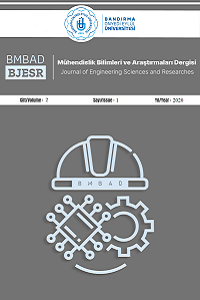Öz
Günlük hayatta metallerden alaşım elde etmek veya kaynak yapabilmek için metallerin eritilmesi, hızlı bir şekilde ısıtılıp soğutulması veya kısmi ısıtmanın gerçekleştirilmesi gerekmektedir. Bu tip ihtiyaçlar için kullanılan etkin yöntemlerden biri de indüksiyon ısıtma sistemidir. Elektromanyetik indüksiyon yöntemi ile ısıtma metal parçası üzerindeki nüve kayıplarının oluşturduğu ısı enerjinin kullanılmasıdır. Bu nüve kayıpları, elektromanyetik alan içerisinde bulunan iş parçasında nüve içinde değişen manyetik alanlar tarafından üretilen eddy akım kayıpları ve demir içinde domainlerin yönünü değiştirmek için oluşan histerisis kayıplarından meydana gelmektedir. Bu çalışmada, aynı ölçülerde farklı malzeme yapısında metal iş parçalarının 5 sarımlı bakır indüksiyon bobini ile farklı çalışma frekansları için bir manyetik model çıkarılarak analiz edilmiştir. Manyetik akı yoğunluğu (B) dağılımları ve iş parçalarındaki deri etkisi incelenerek eddy kayıpları sunulmuştur.
Anahtar Kelimeler
Kaynakça
- [1] N. S. Bayındır, O. Kukrer, M. Yakup, “DSP-based PLL-controlled 50-100 kHz 20 kW high-frequency induction heating system for surface hardening and welding applications”, IEE Proceedings-Electric Power Applications, Vol. 150, No. 3, pp. 365-371, 2003.
- [2] J. M. Espi-Huerta, E. J. D. G. Santamaria, R. G. Gil, J. C. Moreno, “Design of the L-LC resonant inverter for induction heating based on its equivalent SRI”, IEEE Transactions on Industrial Electronics, Vol. 54. No. 6, pp. 3178-3187, 2007.
- [3] O. Lucia, P. Maussion, E. J. Dede, J. M. Burdio, “Induction heating technology and its applications: past developments, current technology, and future challenges”, IEEE Trans. Industrial Electronics, Vol. 61, No. 5, pp. 2509-2520, 2014.
- [4] J. M. Ho, M. T. Lee, “A novel PWM inverter control circuitry for induction heating”, V IEEE International Power Electronics Congress Technical Proceedings, Cuernavaca, Mexico, 113–119, 1996.
- [5] H. Sarnago, A. Mediano, O. Lucia, “High Efficiency AC–AC Power Electronic Converter Applied to Domestic Induction Heating”, IEEE Transactions on Power Electronics, Vol. 27, No. 8, pp. 3676-3684, 2012,
- [6] M.P. Tarragona, H. Sarnago, O. Lucia, J. M. Burdio, “Full-bridge series resonant multi-inverter featuring new 900-V SiC devices for improved induction heating appliances”, IEEE Applied Power Electronics Conference and Exposition (APEC), Long Beach, CA, 1762-1766, March 2016.
- [7] M. H. Tavakoli, H. Karbaschi, F. Samavat, “Computational Modeling of Induction Heating Process”, Progress In Electromagnetics Research Letters, Vol. 11, pp. 99-102, 2009.
- [8] W. Han, K. T. Chau, Z. Zhang, “Flexible Induction Heating Using Magnetic Resonant Coupling”, IEEE Transactions on Industrial Electronics, Vol. 64, No. 3, pp. 1982-1992, 2017,
- [9] H. S. Park, X. P. Dang, “Optimization of the In-line Induction Heating Process for Hot Forging in Terms of Saving Operating Energy”, International Journal of Precision Engineering and Manufacturing, Vol. 13, No. 7, pp. 1085-1093, 2012.
- [10] T. Mishima, Y. Nakagawa, M. Nakaoka, “Bridgeless BHB ZVS-PWM AC–AC Converter for High-Frequency Induction Heating Applications”, IEEE Transactions on Industry Applications, Vol. 51, No. 4, pp. 3304-3315, 2015.
- [11] H. Sarnago, O. Lucia, A. Mediano, J. M. Burdio, “A Class-E Direct AC–AC Converter with Multicycle Modulation for Induction Heating Systems”, IEEE Transactions on Industrial Electronics, Vol. 61, No. 5, pp. 2521-2530, 2014.
- [12] P. Charvin, F. Lemont, A. Russello, “Nuclear waste treatment by induction heating and stirring of a metal/glass bath: the PIVIC process”, 9th International Symposium on Electromagnetic Processing of Materials, 424, October 2018.
- [13] H. M. El-Mashad, Z. Pan, “Application of Induction Heating in Food Processing and Cooking”, Food Eng Rev, Vol. 9, pp. 82-90, 2017.
- [14] S. Çetin, “Bir fazlı bir indüksiyon ısıtma sistemi analizi ve dizaynı”, Yüksek Lisans Tezi, Pamukkale Üniversitesi, Fen Bilimleri Enstitüsü, Denizli, 2005.
- [15] S. Öncü, “Kendinden tetiklemeli indüksiyon ısıtıcı için akım geri beslemeli seri rezonans eviricili sürme devresinin gerçekleştirilmesi ve analizi”, Doktora Tezi, Gazi Üniversitesi Fen Bilimleri Enstitüsü, Ankara, 2011.
- [16] B. Aytekin, “Endüksiyon ocak elektronik kontrol sistem tasarımı”, Yüksek Lisans Tezi, İstanbul Teknik Üniversitesi, Fen Bilimleri Enstitüsü, İstanbul, 2008.
- [17] E. Balbozan, “Endüksiyon Isıtma”, Yüksek Lisans Tezi, Dokuz Eylül Üniversitesi, Fen Bilimleri Enstitüsü, İzmir, 1984.
- [18] C. Tudbury, “Electromagnetics in induction heating", IEEE Transaction on Magnetics, Vol. 10, No. 3, pp. 694–697, 1974.
- [19] Ö. Çelik, “İndüksiyon Fırını Tasarım ve Yapımı”, Yüksek Lisans Tezi, Fırat Üniversitesi, Fen Bilimleri Enstitüsü, Elazığ, 2005.
- [20] İ. Boşnak, “PLC ile PLL kontrollü indüksiyon ısıtma uygulaması”, Yüksek Lisans Tezi, Karabük Üniversitesi, Fen Bilimleri Enstitüsü, Karabük, 2016.
- [21] M. Akbaba, S. Q. Fakhro, “Field distribution and iron loss computation in reluctance augmented shaded-pole motors using finite element method”, IEEE Transactions on Energy Conversion, Vol. 7, No. 2, pp. 302-307, 1992.
- [22] A. Dalcalı, M. Akbaba, “FEM Study of the Effects of Geometric Changes on the Variable Reluctance Shaded-Pole Motors Performance”, Int. Journal of Computing, Communications & Instrumentation Engg., Vol. 4, No. 2, pp. 36-39, 2017.
- [23] L. Ho, W. N. Fu, “Review and Future Application of Finite Element Methods in Induction Motors”, Electric Machines & Power Systems, Vol. 26, No. 2, pp. 111–125, 1992.
- [24] N. Öztürk, A. Dalcalı, E. Çelik, S. Sakar, “Cogging torque reduction by optimal design of PM synchronous generator for wind turbines”, International Journal of Hydrogen Energy, Vol 42, No. 28, pp. 17593-17600, 2017.
Ayrıntılar
| Birincil Dil | Türkçe |
|---|---|
| Konular | Elektrik Mühendisliği |
| Bölüm | Araştırma Makaleleri |
| Yazarlar | |
| Yayımlanma Tarihi | 29 Nisan 2020 |
| Yayımlandığı Sayı | Yıl 2020 Cilt: 2 Sayı: 1 |

